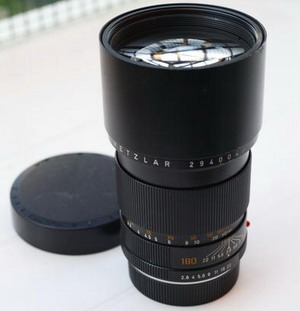Leica ELMARIT-R 180mm f2.8 Lens Review |
|
This is the second and last version of this lens, much more lightweight than the predecessor and also completely changed (and much improved) optically.
After this lens, Leica produced the APO version, which is yet a different design, and a superior lens, which however costs much more.
With it's 850 gr, the Elmarit-R 180 second version is amongst the lightest 180mm lenses of the same speed. Consider for instance that the last version of the Carl Zeiss Jena 2.8/180 Sonnar weights 1400 gr. (and it's also much bulkier).
The optical performance of this Elmarit is within the standard of the last versions of Leica -R lenses.
Fact Sheet
User Comments
The overall optical performance of this apochromatically corrected 180
mm lens can certainly be compared to that of the faster
LEICA APO-SUMMICRON-R 180 mm f/2 lens. Even at full aperture, it is
remarkable for its outstanding image quality. Coma as well
as astigmatism and curvature of field can barely be detected. The
rubber-armored lens hood effectively protects the lens against
damage from impacts. As a lightweight and compact lens with this focal
length, it is very well suited for portraiture, fashion, sports
and landscape photography – even when it is not used on a tripod.
Ingenious mechanical design and pleasing ergonomics make
focusing especially easy.
(Leica Data Sheet)
That is to say that like all last-generation
Elmarits, this lens, too, is perfectly sharp already wide open. This is
a real f/2.8 180mm lens, you can use the full aperture and obtain
fantastic results. This feature really makes the difference when you
have to shoot sports, action, street life, or wildlife, especially in
low light and without a tripod.
Size, speed and performance make of this lens a perfect walk around
lens for people who like to shoot with medium teles.
Stopped down, I personally prefer the "body" and depth of the Sonnar
180's photographs, but this judgment falls within the realm of the
subjective preferences. Wide open, the Elmarit is a lot sharper than
the Sonnar, and has little or no light falloff in the corners (whereas
the Sonnar has plenty).
Colour-wise, this lens is a typical Leica, which means it gives the
pictures a slightly cool tonality. You may or may not like it. I find
it a very desireable feature for portraits (I dislike the ham-red
faces), but not so for landscapes, for which I prefer the more balanced
color rendition of the Carl Zeiss lenses. If the cool tonality of the
Leica lenses is disturbing for you, I suggest the use of a good
skylight filter (such as the B+W one). Of course when shooting digital
RAW the colour tonality can be adjusted effortlessly, but for those who
still shoot slides, this can be a concern.
Conclusion: I can recommend this small, relatively lightweight and fast
180mm lens to every photographer who likes to walk a lot, perhaps
without tripod, and who likes to shoot live events even in not ideal
lighting conditions, and therefore needs a lens that is fully usable
wide open. These are the situations where this lens really shines.
(by Orio Menoni) Tags: |


The lens is heavier than the 180 F/2.8 APO version (also an excellent lens), so I use the 180mm F/3.4 APO which provides stunning results in any lighting condition, and is very lightweight compared to the other Leica 180mm versions.
The other Leica 180 F/2.8 ,non APO version, compares well to other major companies that produce a lens in this focal length range.